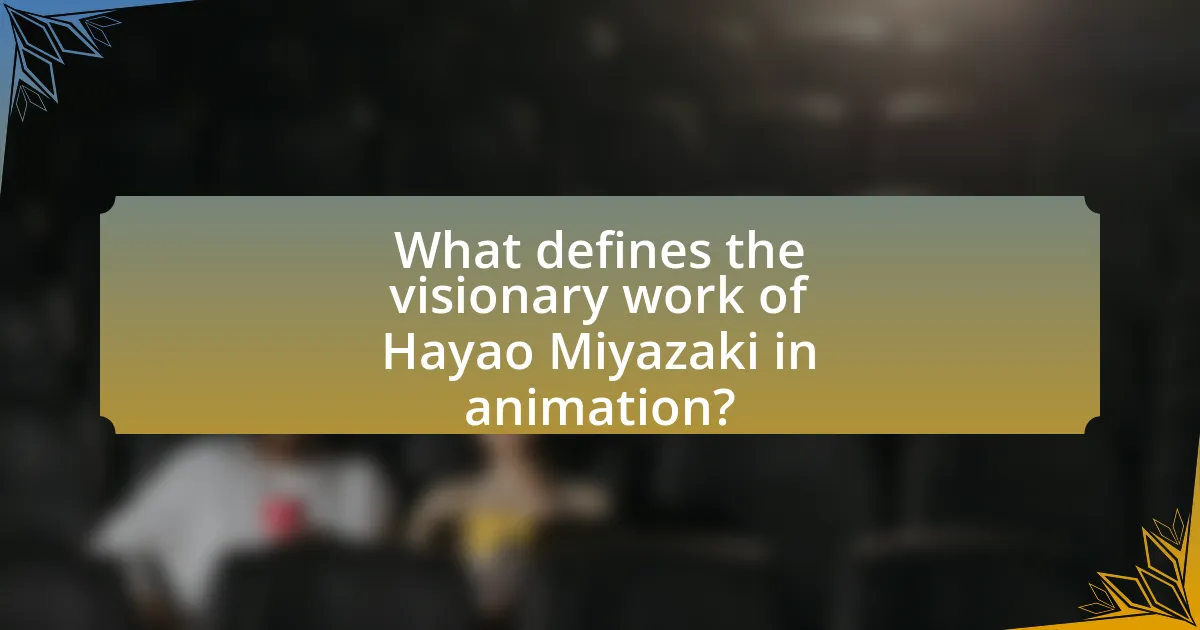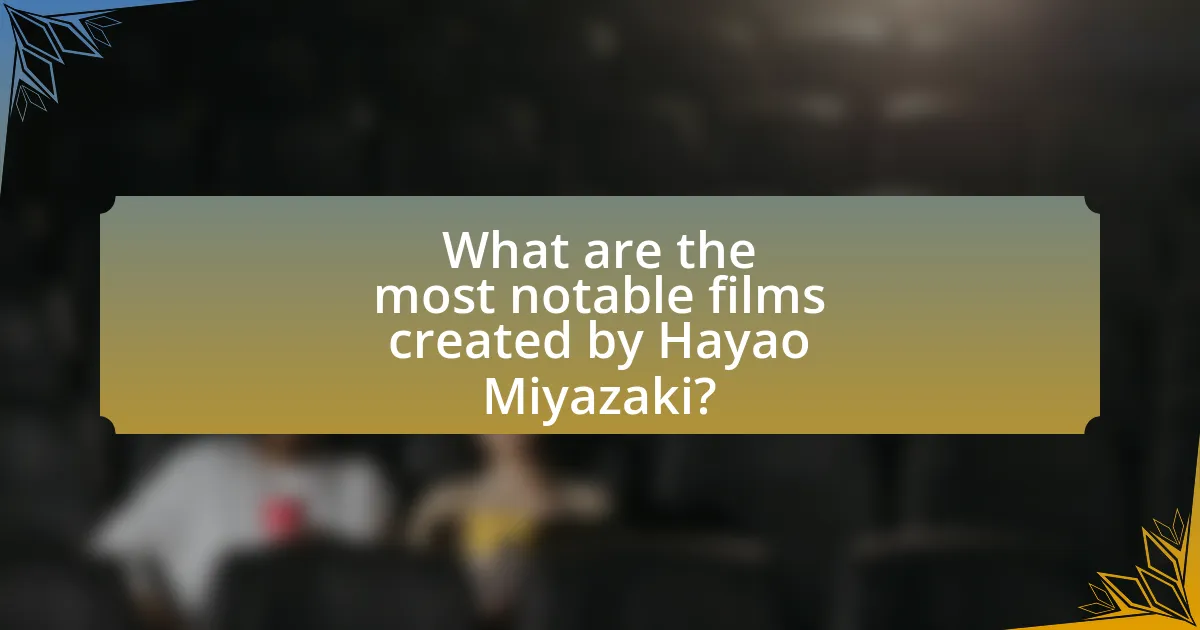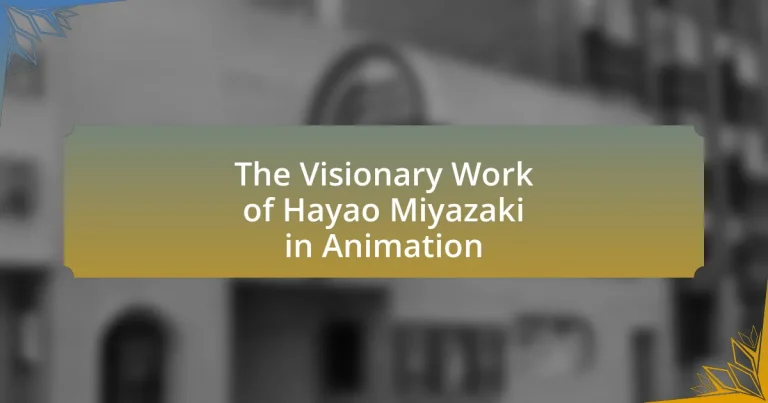Hayao Miyazaki is a renowned figure in animation, celebrated for his unique storytelling, character development, and intricate world-building. His films, such as “Spirited Away,” “My Neighbor Totoro,” and “Princess Mononoke,” explore significant themes including environmentalism, the innocence of childhood, and the complexity of human emotions. The article examines how Miyazaki’s early life and education influenced his artistic vision, the role of female protagonists in his narratives, and the impact of his work on the animation industry. Additionally, it highlights the cultural significance of his films and the lessons contemporary animators can learn from his approach to storytelling and animation techniques.

What defines the visionary work of Hayao Miyazaki in animation?
Hayao Miyazaki’s visionary work in animation is defined by his unique storytelling, rich character development, and intricate world-building. His films often explore themes of nature, pacifism, and the human experience, as seen in works like “Spirited Away,” which won the Academy Award for Best Animated Feature in 2003. Miyazaki’s animation style combines hand-drawn artistry with a deep emotional resonance, creating immersive experiences that resonate with audiences of all ages. His commitment to environmentalism and strong female protagonists further distinguishes his films, making them culturally significant and influential in the animation industry.
How did Hayao Miyazaki’s early life influence his animation style?
Hayao Miyazaki’s early life significantly influenced his animation style by instilling a deep appreciation for nature and storytelling. Growing up in post-war Japan, he was exposed to the beauty of the countryside and the impact of war on society, which shaped his themes of environmentalism and pacifism in films like “My Neighbor Totoro” and “Princess Mononoke.” Additionally, his family’s background in publishing and his mother’s influence as a strong, independent figure contributed to his focus on strong female protagonists and complex narratives. These formative experiences are evident in the rich, detailed worlds and emotional depth present in his animations.
What experiences shaped Miyazaki’s worldview and artistic vision?
Hayao Miyazaki’s worldview and artistic vision were shaped significantly by his childhood experiences during and after World War II, particularly his exposure to the devastation of war and the impact of industrialization on nature. Growing up in a family that ran an aviation business, he developed a fascination with flight and nature, which is reflected in his films. Additionally, his experiences as a young animator in the 1960s, witnessing the evolution of animation and the influence of Western culture, further informed his perspective. His commitment to environmentalism and pacifism, evident in works like “Princess Mononoke” and “My Neighbor Totoro,” stems from these formative experiences, emphasizing the importance of harmony between humanity and nature.
How did his education contribute to his animation techniques?
Hayao Miyazaki’s education significantly shaped his animation techniques by providing him with a strong foundation in art and storytelling. He studied at the Gakushuin University, where he focused on political science but was heavily influenced by his exposure to various forms of art, literature, and film. This diverse educational background allowed him to blend intricate visual styles with deep narrative themes, evident in films like “Spirited Away” and “My Neighbor Totoro.” His understanding of traditional Japanese art forms and Western animation principles, acquired during his studies, enabled him to innovate and create unique animation techniques that emphasize emotional depth and environmental themes.
What are the key themes present in Miyazaki’s films?
The key themes present in Miyazaki’s films include environmentalism, the innocence of childhood, the complexity of human emotions, and the critique of modern society. Environmentalism is prominently featured in films like “Princess Mononoke,” which explores the conflict between nature and industrialization. The innocence of childhood is depicted in “My Neighbor Totoro,” showcasing the wonder and purity of youth. The complexity of human emotions is illustrated in “Spirited Away,” where characters navigate fear, love, and growth. Lastly, the critique of modern society is evident in “Howl’s Moving Castle,” which addresses the impacts of war and consumerism. These themes reflect Miyazaki’s deep understanding of human experiences and his commitment to storytelling that resonates with audiences across generations.
How does environmentalism manifest in his storytelling?
Environmentalism manifests in Hayao Miyazaki’s storytelling through the prominent themes of nature, the interconnectedness of life, and the critique of industrialization. His films often depict lush landscapes and emphasize the beauty and importance of the natural world, as seen in “Princess Mononoke,” where the conflict between humans and nature highlights the consequences of environmental destruction. Additionally, Miyazaki’s characters frequently embody a deep respect for nature, showcasing their relationships with animals and plants, which reinforces the idea of coexistence. The narrative arcs in his works often advocate for environmental stewardship, urging viewers to reflect on their impact on the planet and the necessity of preserving ecological balance.
What role do female protagonists play in his narratives?
Female protagonists in Hayao Miyazaki’s narratives serve as central figures who embody strength, resilience, and emotional depth. These characters often navigate complex worlds, facing challenges that promote personal growth and self-discovery. For instance, in “Spirited Away,” Chihiro transforms from a timid girl into a courageous individual who confronts adversity, illustrating Miyazaki’s emphasis on empowerment and agency in female characters. This focus on female protagonists not only challenges traditional gender roles but also reflects broader themes of environmentalism and social responsibility, as seen in films like “Princess Mononoke,” where San represents the struggle between humanity and nature. Miyazaki’s narratives consistently highlight the importance of female perspectives, making them integral to the storytelling and thematic richness of his work.
How has Miyazaki’s work impacted the animation industry?
Miyazaki’s work has profoundly impacted the animation industry by elevating the medium to a form of high art that emphasizes storytelling, character development, and visual aesthetics. His films, such as “Spirited Away,” which won the Academy Award for Best Animated Feature in 2003, showcase intricate narratives that resonate with both children and adults, setting a new standard for emotional depth in animation. Additionally, his unique hand-drawn animation style has influenced countless animators worldwide, encouraging a shift away from computer-generated imagery towards more traditional techniques. This emphasis on artistry and narrative complexity has inspired a generation of filmmakers, leading to a broader acceptance of animated films as serious cinematic works.
What innovations did he introduce to animation techniques?
Hayao Miyazaki introduced several innovations to animation techniques, notably the use of hand-drawn animation combined with computer-generated imagery (CGI) to enhance visual storytelling. His films, such as “Spirited Away,” showcased a seamless integration of traditional animation with digital effects, allowing for richer textures and more dynamic scenes. Additionally, Miyazaki emphasized the importance of detailed backgrounds and character expressions, which contributed to emotional depth and realism in animated films. His approach to narrative structure, often incorporating themes of environmentalism and feminism, also set a new standard in animation storytelling, influencing both the artistic and thematic direction of the medium.
How has his storytelling influenced contemporary animators?
Hayao Miyazaki’s storytelling has profoundly influenced contemporary animators by emphasizing character-driven narratives and emotional depth. His films, such as “Spirited Away” and “My Neighbor Totoro,” showcase complex characters and rich, immersive worlds that resonate with audiences, encouraging animators to prioritize emotional storytelling over mere spectacle. This approach has led to a shift in animation, where creators like Jennifer Lee of “Frozen” and Pete Docter of “Inside Out” draw inspiration from Miyazaki’s ability to blend fantasy with relatable human experiences, resulting in films that explore themes of identity, growth, and environmentalism. The impact of Miyazaki’s work is evident in the increasing focus on nuanced storytelling in contemporary animated features, reflecting a broader trend towards deeper thematic exploration in the medium.

What are the most notable films created by Hayao Miyazaki?
The most notable films created by Hayao Miyazaki include “Spirited Away,” “My Neighbor Totoro,” “Princess Mononoke,” “Howl’s Moving Castle,” and “Kiki’s Delivery Service.” “Spirited Away,” released in 2001, won the Academy Award for Best Animated Feature and is celebrated for its imaginative storytelling and rich animation. “My Neighbor Totoro,” released in 1988, is iconic for its heartwarming themes and has become a cultural symbol in Japan. “Princess Mononoke,” released in 1997, is recognized for its environmental themes and complex characters. “Howl’s Moving Castle,” released in 2004, received critical acclaim for its animation and narrative depth. “Kiki’s Delivery Service,” released in 1989, is notable for its coming-of-age story and charming visuals. These films exemplify Miyazaki’s unique style and storytelling prowess, contributing significantly to the field of animation.
What makes “Spirited Away” a landmark film in animation history?
“Spirited Away” is a landmark film in animation history due to its groundbreaking storytelling, rich visual artistry, and cultural significance. The film, directed by Hayao Miyazaki and released in 2001, became the highest-grossing film in Japanese history, earning over $395 million worldwide. Its unique narrative, which blends elements of Japanese folklore with universal themes of identity and resilience, has resonated with audiences globally. Additionally, “Spirited Away” won the Academy Award for Best Animated Feature in 2003, marking a significant recognition of animation as a serious art form. The film’s intricate animation techniques and attention to detail set new standards in the industry, influencing countless animators and filmmakers.
How did “Spirited Away” achieve critical and commercial success?
“Spirited Away” achieved critical and commercial success through its unique storytelling, stunning animation, and universal themes. The film, directed by Hayao Miyazaki, captivated audiences with its imaginative world and deep emotional resonance, leading to a box office gross of over $400 million worldwide, making it the highest-grossing film in Japanese history at the time of its release in 2001. Additionally, “Spirited Away” received numerous accolades, including the Academy Award for Best Animated Feature in 2003, which solidified its status as a masterpiece in animation and contributed to its enduring legacy.
What themes are explored in “Spirited Away”?
“Spirited Away” explores themes of identity, consumerism, environmentalism, and the transition from childhood to adulthood. The protagonist, Chihiro, undergoes a journey of self-discovery as she navigates a spirit world, reflecting the theme of identity. The film critiques consumerism through the character of No-Face, who represents the emptiness of material desire. Environmentalism is highlighted through the depiction of polluted rivers and the importance of nature, as seen in the character of Haku, who is linked to the river spirit. Additionally, Chihiro’s growth symbolizes the challenges of growing up, emphasizing the loss of innocence and the need for resilience. These themes are interwoven to create a rich narrative that resonates with audiences on multiple levels.
How does “My Neighbor Totoro” reflect Miyazaki’s artistic vision?
“My Neighbor Totoro” reflects Miyazaki’s artistic vision through its emphasis on nature, childhood innocence, and the importance of family. The film showcases Miyazaki’s belief in the interconnectedness of humans and the natural world, as seen in the portrayal of magical creatures like Totoro, who embodies the spirit of the forest. Additionally, the narrative focuses on the experiences of two young sisters, highlighting the purity and wonder of childhood, which is a recurring theme in Miyazaki’s work. The film’s hand-drawn animation style further exemplifies his commitment to traditional artistry, creating a visually rich and immersive experience that resonates with audiences. This combination of themes and artistic techniques underscores Miyazaki’s vision of storytelling that celebrates both the beauty of nature and the simplicity of human relationships.
What cultural significance does “My Neighbor Totoro” hold in Japan?
“My Neighbor Totoro” holds significant cultural importance in Japan as it embodies themes of childhood innocence, nature, and familial bonds. The film, released in 1988, has become a symbol of Japanese animation and is often associated with the Studio Ghibli brand, which has influenced global perceptions of Japanese culture. Its iconic character, Totoro, represents a guardian spirit of the forest, reflecting Shinto beliefs about nature and the environment. The film’s portrayal of rural life and the simplicity of childhood resonates deeply with Japanese audiences, reinforcing cultural values of harmony with nature and the importance of family. Additionally, “My Neighbor Totoro” has inspired various merchandise, theme park attractions, and cultural events, solidifying its status as a beloved cultural icon in Japan.
How does the film portray childhood and imagination?
The film portrays childhood and imagination as vibrant and transformative forces that shape personal identity and perception of the world. Through characters like Chihiro in “Spirited Away,” the narrative emphasizes the innocence and curiosity of youth, showcasing how imaginative experiences can lead to growth and self-discovery. The film employs fantastical elements, such as spirits and magical realms, to illustrate the boundless nature of a child’s imagination, reinforcing the idea that creativity is essential for navigating life’s challenges. This portrayal aligns with Miyazaki’s broader themes of environmentalism and the importance of maintaining a childlike wonder in adulthood.
What are the unique characteristics of “Princess Mononoke”?
“Princess Mononoke” is characterized by its complex themes of environmentalism, the coexistence of nature and industrialization, and moral ambiguity. The film presents a rich narrative that explores the conflict between humans and nature, embodied by the characters Ashitaka and San, who represent different perspectives on this struggle. Additionally, the animation style is notable for its detailed landscapes and fluid character movements, which enhance the storytelling. The film’s score, composed by Joe Hisaishi, further elevates its emotional depth, creating a powerful atmosphere that complements the visual artistry. These elements collectively contribute to “Princess Mononoke” being recognized as a landmark in animated cinema, reflecting Hayao Miyazaki’s visionary approach to storytelling and animation.
How does “Princess Mononoke” address the conflict between nature and industrialization?
“Princess Mononoke” addresses the conflict between nature and industrialization by depicting the struggle between the forest spirits and the encroaching ironworks led by Lady Eboshi. The film illustrates the destructive impact of industrialization on the environment, showcasing scenes where forests are devastated for resources, which leads to the suffering of both nature and its inhabitants. This conflict is embodied in the character of Ashitaka, who seeks to mediate between the two opposing forces, emphasizing the need for coexistence and understanding. The narrative ultimately suggests that both nature and industrial progress can coexist, but only through respect and balance, as seen in the resolution where characters begin to recognize the consequences of their actions on the ecosystem.
What are the moral complexities presented in the film?
The moral complexities presented in Hayao Miyazaki’s films often revolve around the themes of environmentalism, the duality of human nature, and the consequences of war. For instance, in “Princess Mononoke,” the conflict between industrialization and nature illustrates the struggle between progress and ecological preservation, highlighting the moral ambiguity of both sides. Additionally, characters like Ashitaka embody the complexity of human emotions, showcasing the capacity for both good and evil, which challenges simplistic moral judgments. These narratives compel viewers to reflect on their values and the impact of their choices, reinforcing the idea that morality is not black and white but rather a spectrum influenced by context and perspective.
How does Hayao Miyazaki’s work continue to resonate with audiences today?
Hayao Miyazaki’s work continues to resonate with audiences today due to its universal themes of environmentalism, the complexity of human emotions, and the celebration of imagination. His films, such as “Spirited Away,” which won the Academy Award for Best Animated Feature in 2003, explore deep moral questions and showcase richly developed characters that reflect real-life struggles and triumphs. The emotional depth and artistic craftsmanship in his storytelling have led to a lasting impact, as evidenced by the continued popularity of Studio Ghibli films, which have amassed a global fanbase and critical acclaim over decades. Additionally, Miyazaki’s focus on nature and the consequences of industrialization aligns with contemporary concerns about climate change, making his narratives increasingly relevant in today’s societal context.
What lessons can modern animators learn from Miyazaki’s approach?
Modern animators can learn the importance of storytelling and emotional depth from Miyazaki’s approach. His films, such as “Spirited Away,” emphasize character development and intricate narratives that resonate with audiences of all ages. Miyazaki’s commitment to hand-drawn animation showcases the value of craftsmanship and artistic integrity, as seen in the meticulous detail of backgrounds and character expressions in his works. Additionally, his focus on environmental themes and cultural elements encourages animators to incorporate meaningful messages into their projects, fostering a deeper connection with viewers. This combination of rich storytelling, artistic dedication, and thematic relevance serves as a guiding framework for contemporary animators seeking to create impactful and memorable animated films.
How can Miyazaki’s themes be applied to contemporary storytelling?
Miyazaki’s themes can be applied to contemporary storytelling by emphasizing environmentalism, the complexity of human emotions, and the importance of personal growth. His films often showcase a deep connection to nature, urging modern narratives to incorporate ecological awareness and sustainability, as seen in works like “Princess Mononoke,” which highlights the conflict between industrialization and nature. Additionally, Miyazaki’s characters frequently navigate intricate emotional landscapes, encouraging contemporary stories to explore nuanced relationships and personal struggles, similar to the character development in “Spirited Away.” Lastly, the theme of self-discovery and transformation, prevalent in films like “Howl’s Moving Castle,” can inspire contemporary storytelling to focus on character arcs that reflect resilience and change in the face of adversity.
What techniques can animators adopt from his style?
Animators can adopt techniques from Hayao Miyazaki’s style, such as the use of detailed backgrounds, strong character development, and the incorporation of nature as a central theme. Miyazaki’s films often feature meticulously crafted environments that enhance storytelling, as seen in “Spirited Away,” where the lush, vibrant settings contribute to the film’s immersive experience. Additionally, his characters are often complex and relatable, allowing audiences to connect emotionally, exemplified by Chihiro’s growth throughout “Spirited Away.” Furthermore, Miyazaki frequently emphasizes the beauty and importance of nature, which can inspire animators to create narratives that reflect environmental themes, as demonstrated in “Princess Mononoke.” These techniques not only enrich the visual appeal of animations but also deepen the narrative impact.
What are some practical tips for appreciating Miyazaki’s films?
To appreciate Miyazaki’s films, viewers should immerse themselves in the cultural and thematic elements present in his storytelling. Engaging with the rich symbolism, such as nature’s importance and the critique of industrialization, enhances understanding. Additionally, watching the films multiple times reveals deeper layers and character development, as Miyazaki often embeds subtle details that contribute to the narrative. Exploring the soundtracks, composed by Joe Hisaishi, can also deepen appreciation, as the music complements the emotional tone of the films. Lastly, reading interviews and analyses of Miyazaki’s work provides context and insights into his creative process, enriching the viewing experience.
How can viewers engage more deeply with the themes in his work?
Viewers can engage more deeply with the themes in Hayao Miyazaki’s work by analyzing the intricate narratives and character development present in his films. For instance, films like “Spirited Away” and “My Neighbor Totoro” explore themes of environmentalism, childhood innocence, and the clash between tradition and modernity. Engaging with these themes can be enhanced by viewing the films multiple times, participating in discussions, and exploring supplementary materials such as interviews and documentaries that provide insight into Miyazaki’s creative process and philosophical beliefs. This approach allows viewers to appreciate the layered storytelling and the cultural context that informs his work, thereby fostering a deeper understanding of the underlying messages.
What should audiences look for when watching a Miyazaki film?
Audiences should look for themes of environmentalism, strong female protagonists, and intricate world-building when watching a Miyazaki film. Miyazaki often emphasizes the connection between humans and nature, as seen in films like “Princess Mononoke,” which critiques industrialization and advocates for ecological balance. Additionally, his films frequently feature complex female characters, such as Chihiro in “Spirited Away,” who undergo significant personal growth and empowerment. The detailed and imaginative worlds he creates, exemplified in “My Neighbor Totoro,” invite viewers to explore rich narratives and cultural elements, enhancing the overall viewing experience.


